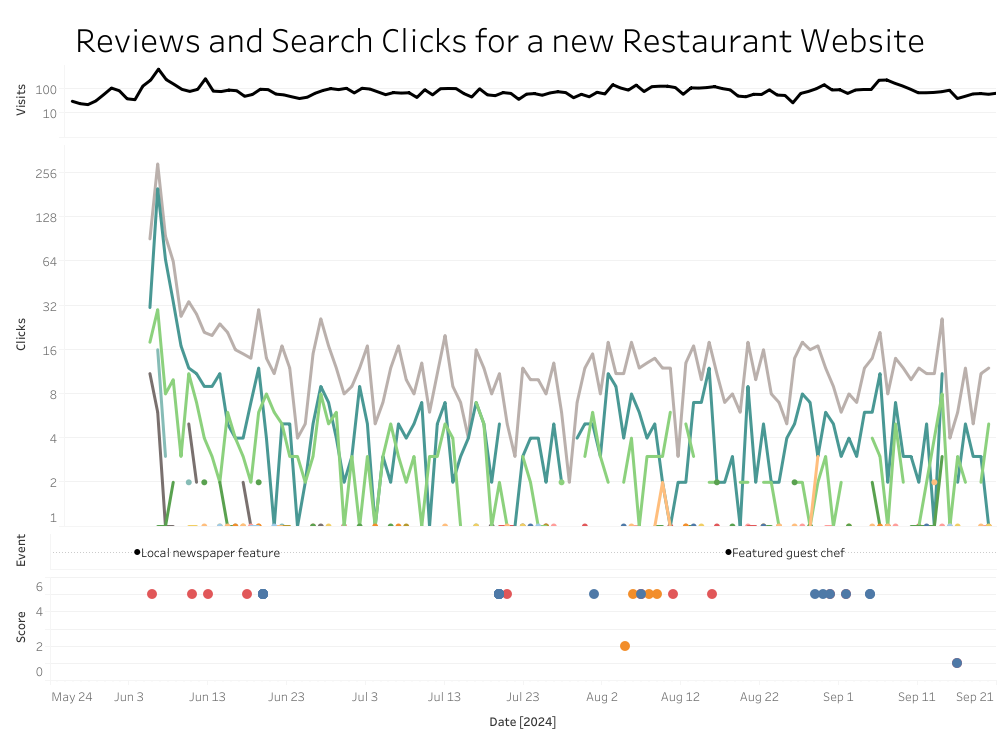How Do Online Reviews Affect Web Traffic?
I have been working with a small business owner who recently purchased and rebranded a restaurant. The new re-launched restaurant has an upscale menu of a cuisine that is uncommon in the area, and a selection of exclusive wines. The business also hosts special events, live music, and dancing.
We have been focussed on SEO strategy, reviews, and the general online presence. Early reviews had largely been five-star reviews posted by patrons with an interest in seeing the business succeed because they value it as a place to spend time. When the first review on Tripadvisor was 2 out of 5, we began to wonder how the restaurant’s first negative review might affect web traffic.
Whenever there is a uncertainty, it is valuable to assess available data. Here is the quick analysis I did.
Approach
There is no clear hypothesis to test, so the most appropriate course of action is to visualize and/or summarize relevant data. We can then potentially develop hypotheses or KPIs to investigate using future data.
My approach was simply to combine several relevant datasets, align them over time, and visually look for patterns. Smoothing is an option, but I have enough experience that I can generally identify patterns without this and I prefer to see the variability of the raw data.
Data were obtained for the time from website launch (May 25) through September 20. I combined the following datasets:
- Daily website visits from Squarespace.
- Daily search clicks from Google Search Console.
- I included the totals as well as the clicks for each search term that had at least 5 clicks in the entire time period.
- Most of the search terms included the name of the business; I have anonymized these for public posting.
- Review scores and dates from
Google*, Tripadvisor, and Yelp
- I also pulled out some keywords from the review text and anonymized these.
- I created an “events” dataset to represent two notable events: a newspaper feature on June 6 and a special event featuring a well-known guest chef on August 18.
I then plotted these over time on a Tableau dashboard.
Note: Google only reports review dates as “__ days/weeks/months ago”. I cross-referenced the reviews to other sites where possible (i.e. looked for an identical review or another review obviously from the same person around the same time) to impute dates. Where this was not possible, I subtracted the stated time interval from the date of data collection (September 20). Therefore the earlier Google review dates are approximate and the reviews may actually be older than the reported date.
Analysis
An image of the dashboard appears below. The visits and clicks are shown on a logarithmic scale to suppress spikes; I encourage you to view the dashboard yourself and examine the raw numbers.
My observations are:
- There is a lot of noise and variability in the clicks data.
- Five-star ratings overwhelm the three low ratings.
- The only patterns I see are:
- A huge spike in both traffic and search clicks right after the newspaper feature.
- Traffic roughly doubled at the beginning of August and then tapered off gradually.
I looked at search clicks one keyword at a time and still did not see major patterns of note for individual search terms.
The spike coincided with the newspaper feature, and the doubling in traffic occurred right around the time that promotion for the guest chef event began. We have not done any sort of A/B test or any other way to establish statistical causation, but given domain knowledge these would be reasonable causes. The newspaper feature would result in people searching for the restaurant by name, and the event promotion would drive traffic from social media and other sources.
From this I conclude that web traffic is likely more responsive to other marketing efforts than to the (small number of) reviews. We should continue monitoring, but I recommend that the business owner spend less energy thinking about reviews and more on other marketing efforts.
Discussion and Commentary
This is a great example of the inherent value of using data to fill in a knowledge gap. The analysis did not conclusively answer the questions, but that outcome can still be used to make decisions. Namely, those decisions are to focus less on reviews in the immediate future, and to collect more data.
Regardless of the effect of reviews on traffic, it was healthy to be concerned about the first two-star review. This happened to be the first review on Tripadvisor, which means that this was the only perspective that Tripadvisor users would see. Furthermore, Tripadvisor ratings are shown on Bing search results. I focussed on Google because Google has the largest market share among patrons, but we might see a different story by including Bing data. (More data—yay!)
The first poor reviews on Google and Yelp came on September 16, shortly before data collection for this analysis. If anything, these arrived after traffic and clicks had already declined following the guest chef event and the summer rush, but it will be interesting to continue to monitor Google search outcomes.
The overall story I see in the clicks data is that of search engines discovering a new site and the outcomes of marketing driving clicks. Knowing that there is not much to know has value even if only in terms of opportunity cost, so this business owner has made a smart choice by making sense of data early.

